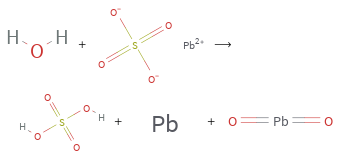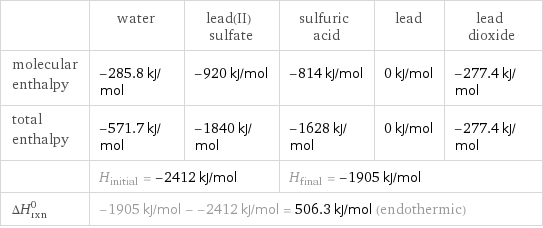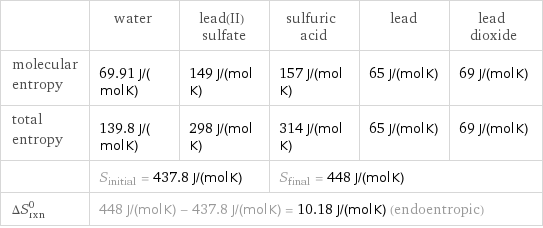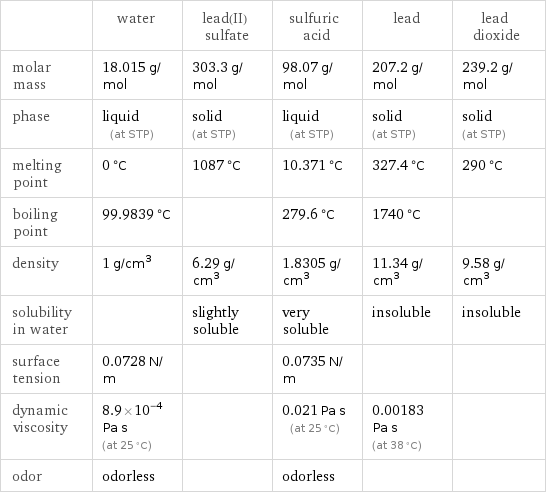Input interpretation

H_2O water + PbSO_4 lead(II) sulfate ⟶ H_2SO_4 sulfuric acid + Pb lead + PbO_2 lead dioxide
Balanced equation

Balance the chemical equation algebraically: H_2O + PbSO_4 ⟶ H_2SO_4 + Pb + PbO_2 Add stoichiometric coefficients, c_i, to the reactants and products: c_1 H_2O + c_2 PbSO_4 ⟶ c_3 H_2SO_4 + c_4 Pb + c_5 PbO_2 Set the number of atoms in the reactants equal to the number of atoms in the products for H, O, Pb and S: H: | 2 c_1 = 2 c_3 O: | c_1 + 4 c_2 = 4 c_3 + 2 c_5 Pb: | c_2 = c_4 + c_5 S: | c_2 = c_3 Since the coefficients are relative quantities and underdetermined, choose a coefficient to set arbitrarily. To keep the coefficients small, the arbitrary value is ordinarily one. For instance, set c_4 = 1 and solve the system of equations for the remaining coefficients: c_1 = 2 c_2 = 2 c_3 = 2 c_4 = 1 c_5 = 1 Substitute the coefficients into the chemical reaction to obtain the balanced equation: Answer: | | 2 H_2O + 2 PbSO_4 ⟶ 2 H_2SO_4 + Pb + PbO_2
Structures

+ ⟶ + +
Names

water + lead(II) sulfate ⟶ sulfuric acid + lead + lead dioxide
Reaction thermodynamics
Enthalpy

| water | lead(II) sulfate | sulfuric acid | lead | lead dioxide molecular enthalpy | -285.8 kJ/mol | -920 kJ/mol | -814 kJ/mol | 0 kJ/mol | -277.4 kJ/mol total enthalpy | -571.7 kJ/mol | -1840 kJ/mol | -1628 kJ/mol | 0 kJ/mol | -277.4 kJ/mol | H_initial = -2412 kJ/mol | | H_final = -1905 kJ/mol | | ΔH_rxn^0 | -1905 kJ/mol - -2412 kJ/mol = 506.3 kJ/mol (endothermic) | | | |
Entropy

| water | lead(II) sulfate | sulfuric acid | lead | lead dioxide molecular entropy | 69.91 J/(mol K) | 149 J/(mol K) | 157 J/(mol K) | 65 J/(mol K) | 69 J/(mol K) total entropy | 139.8 J/(mol K) | 298 J/(mol K) | 314 J/(mol K) | 65 J/(mol K) | 69 J/(mol K) | S_initial = 437.8 J/(mol K) | | S_final = 448 J/(mol K) | | ΔS_rxn^0 | 448 J/(mol K) - 437.8 J/(mol K) = 10.18 J/(mol K) (endoentropic) | | | |
Equilibrium constant
![Construct the equilibrium constant, K, expression for: H_2O + PbSO_4 ⟶ H_2SO_4 + Pb + PbO_2 Plan: • Balance the chemical equation. • Determine the stoichiometric numbers. • Assemble the activity expression for each chemical species. • Use the activity expressions to build the equilibrium constant expression. Write the balanced chemical equation: 2 H_2O + 2 PbSO_4 ⟶ 2 H_2SO_4 + Pb + PbO_2 Assign stoichiometric numbers, ν_i, using the stoichiometric coefficients, c_i, from the balanced chemical equation in the following manner: ν_i = -c_i for reactants and ν_i = c_i for products: chemical species | c_i | ν_i H_2O | 2 | -2 PbSO_4 | 2 | -2 H_2SO_4 | 2 | 2 Pb | 1 | 1 PbO_2 | 1 | 1 Assemble the activity expressions accounting for the state of matter and ν_i: chemical species | c_i | ν_i | activity expression H_2O | 2 | -2 | ([H2O])^(-2) PbSO_4 | 2 | -2 | ([PbSO4])^(-2) H_2SO_4 | 2 | 2 | ([H2SO4])^2 Pb | 1 | 1 | [Pb] PbO_2 | 1 | 1 | [PbO2] The equilibrium constant symbol in the concentration basis is: K_c Mulitply the activity expressions to arrive at the K_c expression: Answer: | | K_c = ([H2O])^(-2) ([PbSO4])^(-2) ([H2SO4])^2 [Pb] [PbO2] = (([H2SO4])^2 [Pb] [PbO2])/(([H2O])^2 ([PbSO4])^2)](../image_source/e52db47609d348f2942139dc919db935.png)
Construct the equilibrium constant, K, expression for: H_2O + PbSO_4 ⟶ H_2SO_4 + Pb + PbO_2 Plan: • Balance the chemical equation. • Determine the stoichiometric numbers. • Assemble the activity expression for each chemical species. • Use the activity expressions to build the equilibrium constant expression. Write the balanced chemical equation: 2 H_2O + 2 PbSO_4 ⟶ 2 H_2SO_4 + Pb + PbO_2 Assign stoichiometric numbers, ν_i, using the stoichiometric coefficients, c_i, from the balanced chemical equation in the following manner: ν_i = -c_i for reactants and ν_i = c_i for products: chemical species | c_i | ν_i H_2O | 2 | -2 PbSO_4 | 2 | -2 H_2SO_4 | 2 | 2 Pb | 1 | 1 PbO_2 | 1 | 1 Assemble the activity expressions accounting for the state of matter and ν_i: chemical species | c_i | ν_i | activity expression H_2O | 2 | -2 | ([H2O])^(-2) PbSO_4 | 2 | -2 | ([PbSO4])^(-2) H_2SO_4 | 2 | 2 | ([H2SO4])^2 Pb | 1 | 1 | [Pb] PbO_2 | 1 | 1 | [PbO2] The equilibrium constant symbol in the concentration basis is: K_c Mulitply the activity expressions to arrive at the K_c expression: Answer: | | K_c = ([H2O])^(-2) ([PbSO4])^(-2) ([H2SO4])^2 [Pb] [PbO2] = (([H2SO4])^2 [Pb] [PbO2])/(([H2O])^2 ([PbSO4])^2)
Rate of reaction
![Construct the rate of reaction expression for: H_2O + PbSO_4 ⟶ H_2SO_4 + Pb + PbO_2 Plan: • Balance the chemical equation. • Determine the stoichiometric numbers. • Assemble the rate term for each chemical species. • Write the rate of reaction expression. Write the balanced chemical equation: 2 H_2O + 2 PbSO_4 ⟶ 2 H_2SO_4 + Pb + PbO_2 Assign stoichiometric numbers, ν_i, using the stoichiometric coefficients, c_i, from the balanced chemical equation in the following manner: ν_i = -c_i for reactants and ν_i = c_i for products: chemical species | c_i | ν_i H_2O | 2 | -2 PbSO_4 | 2 | -2 H_2SO_4 | 2 | 2 Pb | 1 | 1 PbO_2 | 1 | 1 The rate term for each chemical species, B_i, is 1/ν_i(Δ[B_i])/(Δt) where [B_i] is the amount concentration and t is time: chemical species | c_i | ν_i | rate term H_2O | 2 | -2 | -1/2 (Δ[H2O])/(Δt) PbSO_4 | 2 | -2 | -1/2 (Δ[PbSO4])/(Δt) H_2SO_4 | 2 | 2 | 1/2 (Δ[H2SO4])/(Δt) Pb | 1 | 1 | (Δ[Pb])/(Δt) PbO_2 | 1 | 1 | (Δ[PbO2])/(Δt) (for infinitesimal rate of change, replace Δ with d) Set the rate terms equal to each other to arrive at the rate expression: Answer: | | rate = -1/2 (Δ[H2O])/(Δt) = -1/2 (Δ[PbSO4])/(Δt) = 1/2 (Δ[H2SO4])/(Δt) = (Δ[Pb])/(Δt) = (Δ[PbO2])/(Δt) (assuming constant volume and no accumulation of intermediates or side products)](../image_source/8c47edc707743ddfbbb1cc934063887e.png)
Construct the rate of reaction expression for: H_2O + PbSO_4 ⟶ H_2SO_4 + Pb + PbO_2 Plan: • Balance the chemical equation. • Determine the stoichiometric numbers. • Assemble the rate term for each chemical species. • Write the rate of reaction expression. Write the balanced chemical equation: 2 H_2O + 2 PbSO_4 ⟶ 2 H_2SO_4 + Pb + PbO_2 Assign stoichiometric numbers, ν_i, using the stoichiometric coefficients, c_i, from the balanced chemical equation in the following manner: ν_i = -c_i for reactants and ν_i = c_i for products: chemical species | c_i | ν_i H_2O | 2 | -2 PbSO_4 | 2 | -2 H_2SO_4 | 2 | 2 Pb | 1 | 1 PbO_2 | 1 | 1 The rate term for each chemical species, B_i, is 1/ν_i(Δ[B_i])/(Δt) where [B_i] is the amount concentration and t is time: chemical species | c_i | ν_i | rate term H_2O | 2 | -2 | -1/2 (Δ[H2O])/(Δt) PbSO_4 | 2 | -2 | -1/2 (Δ[PbSO4])/(Δt) H_2SO_4 | 2 | 2 | 1/2 (Δ[H2SO4])/(Δt) Pb | 1 | 1 | (Δ[Pb])/(Δt) PbO_2 | 1 | 1 | (Δ[PbO2])/(Δt) (for infinitesimal rate of change, replace Δ with d) Set the rate terms equal to each other to arrive at the rate expression: Answer: | | rate = -1/2 (Δ[H2O])/(Δt) = -1/2 (Δ[PbSO4])/(Δt) = 1/2 (Δ[H2SO4])/(Δt) = (Δ[Pb])/(Δt) = (Δ[PbO2])/(Δt) (assuming constant volume and no accumulation of intermediates or side products)
Chemical names and formulas

| water | lead(II) sulfate | sulfuric acid | lead | lead dioxide formula | H_2O | PbSO_4 | H_2SO_4 | Pb | PbO_2 Hill formula | H_2O | O_4PbS | H_2O_4S | Pb | O_2Pb name | water | lead(II) sulfate | sulfuric acid | lead | lead dioxide
Substance properties

| water | lead(II) sulfate | sulfuric acid | lead | lead dioxide molar mass | 18.015 g/mol | 303.3 g/mol | 98.07 g/mol | 207.2 g/mol | 239.2 g/mol phase | liquid (at STP) | solid (at STP) | liquid (at STP) | solid (at STP) | solid (at STP) melting point | 0 °C | 1087 °C | 10.371 °C | 327.4 °C | 290 °C boiling point | 99.9839 °C | | 279.6 °C | 1740 °C | density | 1 g/cm^3 | 6.29 g/cm^3 | 1.8305 g/cm^3 | 11.34 g/cm^3 | 9.58 g/cm^3 solubility in water | | slightly soluble | very soluble | insoluble | insoluble surface tension | 0.0728 N/m | | 0.0735 N/m | | dynamic viscosity | 8.9×10^-4 Pa s (at 25 °C) | | 0.021 Pa s (at 25 °C) | 0.00183 Pa s (at 38 °C) | odor | odorless | | odorless | |
Units
